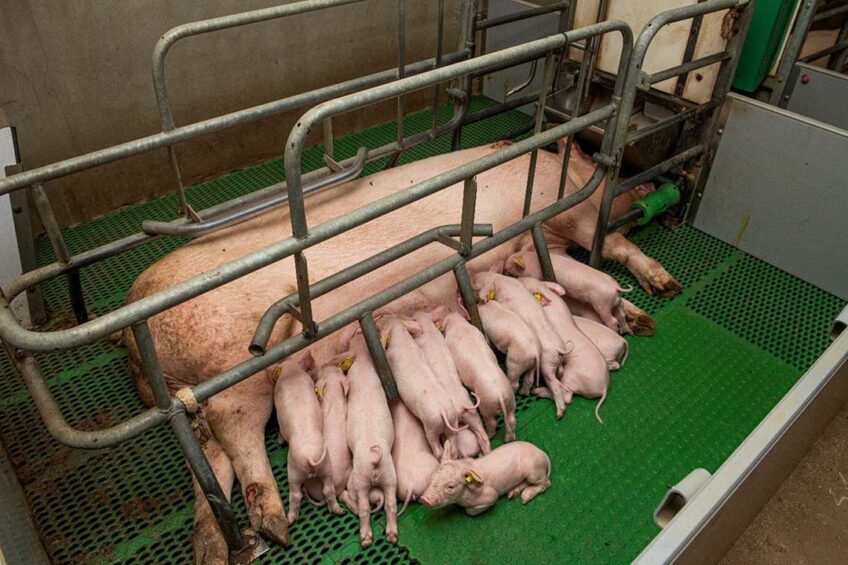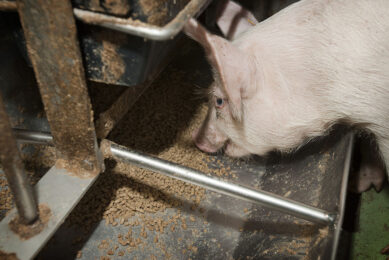Benefits of optimising feed protein for sows and piglets

Optimising feed protein can have several benefits for sows and piglets. Reducing undigested protein levels can reduce diarrhoea in piglets and cutting crude protein in lactating sow diets can increase feed intake, milk production and piglet vitality.
In piglet nutrition, there are various reasons to never stop thinking about optimising protein levels. After all, one of the most successful ways to reduce diarrhoea is to reduce the amount of undigested protein that can enter the large intestine. Since undigested protein is a substrate for pathogenic bacteria, reduction of crude protein will result in less intestinal disorders. Moreover, the undigested protein will be transformed into biogenic amines, such as ammonia, histamine, spermidine and putrescine that will irritate the intestinal wall and represent an extra risk factor for diarrhoea.
There are 3 ways to reduce the amount of undigestible protein:
- by reducing the crude protein in the diet;
- by improving the protein digestibility in the feed; and
- by reducing endogenous protein losses in the intestine.

The effects of undigested protein
The effect of undigested protein on diarrhoea was clearly concluded by a team led by Diana Luise at the University of Bologna in Italy in 2021. The team conducted a meta analysis of 26 trials with different protein contents in piglets. In most of these trials, there was less diarrhoea when the protein content of the feed had been reduced. Moreover, the growth performance and feed conversion ratio (FCR) levels did not deteriorate.
Optimising the balance between digestible amino acids for growth performance and limiting the protein content in the diet as risk factor against diarrhoea is commonly applied by pig feed nutritionists since the pig sector’s global objective is to reduce antibiotics use. The European ban on therapeutic levels of zinc oxide in piglet diets further increased the search for alternative ways to prevent diarrhoea in piglets.

The effect of undigested protein on diarrhoea in piglets was presented in 2023 at the Swine Research Days (JRP) in St Malo, France by a team around Arnaud Samson of ADM. His team tested feed that was based on the (standard) digestibility of raw materials for growing-finishing pigs with feed based on dedicated piglet digestibility of raw materials, assessed on the basis of digestibility trials with piglets. In Figure 1 it is shown that reduction of undigestible protein based on digestibility led to a reduction in diarrhoea, while reduction of undigestible protein based on the digestibility that was determined in finisher pigs did not.

Ileal protein digestibility
Schothorst Feed Research (SFR) also developed a system for ileal protein digestibility in piglets, based on several digestibility trials and in vitro tests on protein characteristics. Figure 2 shows that the ileal protein digestibility is lower for piglets than it is for growing finishing pigs for all raw materials, but that this difference depends on the raw material that was tested. This system enables nutritionists to design piglet feed formulas with low undigested protein to prevent diarrhoea.

Reducing protein levels for sows
Moving from piglets to lactating sows, there also several feeding experiments have been done to determine the effects of protein levels in the feed on feed intake, milk production and piglet vitality. At SFR an experiment was conducted with different protein levels in lactation feed. It was demonstrated that lowering the protein content of the feed resulted in increased feed intake (see Figure 3). This effect of protein content was similar for all parities.
These results were in agreement with Dr Bruno Silva in 2009, who at the time was connected to the French Institute for Agricultural Research (INRA) in Guadeloupe, the West Indies. Back then, he and his team conducted a similar experiment and also found higher feed intake with lower levels of crude protein in the feed. Moreover, they reported that sows fed the low crude protein diet lost less backfat and weight, as compared to the sows fed the high crude protein diet (see Table 1).

Increased milk production
Recently, Chinese researchers conducted a similar experiment and they found that reducing the crude protein level in lactation diets increased milk production (Figure 4). They explain that by the fact that the utilisation of energy from the diet is higher when decreasing the protein content of the feed. The reason for this is that the metabolic losses of the conversation of gross energy to net energy in pigs are much higher for protein than for starch and fat.
Heat loss
More energy is lost as body heat when proteins are used as a source of energy. These heat losses can be calculated as the difference between metabolisable energy and net energy. This explains why lactating sows, especially under heat stress conditions, eat more from low protein diets than from high protein diets, because low protein diets produce less body heat, reducing the heat stress for the sows.
Figure 5 – The effect of crude production in the diet around farrowing on the duration of the farrowing process.

In 2008, a team around David Tydlitát of veterinary consultancy company Sevaron in the Czech Republic also conducted an experiment with crude protein levels in lactating sows. They found that the birth process was faster with low crude protein diets as compared to high crude protein levels (see Figure 5). A short duration of the farrowing process leads to fewer dead born piglets and to more vital piglets.
Protein in sow and piglet diets
It is clear that with dedicated formulation of protein in the piglets and lactating sow feeds important health and production benefits can be achieved. Of course the animals’ requirements for digestible amino acids should be met when reducing the crude protein level in the feed. That may result in more free amino acids and more feedstuffs with a high protein digestibility being incorporated into the feed, leading to an increase of the feed price.
In diets designed to support piglet intestinal health, amino acids with a specific function for the immune system and health of the intestinal tract, such as extra tryptophan and threonine are also needed. Another advantage of reducing crude and undigestible protein in pig feed is that the excretion of ammonia from the manure will be reduced, leading to a better climate in the stable and less respiratory problems for the farmer and the pigs.
Conclusion
Diarrhoea in piglets can be prevented by reducing the amount of undigestible or crude protein in the feed. In lactating sows feed intake, milk production and piglet vitality can be improved by cutting the crude protein content of the feed. This can be achieved by dedicated formulation of the protein and amino acid composition of the feed, taking into account the digestibility of the raw materials and the level of essential and semi essential amino acids.
 Beheer
Beheer








 WP Admin
WP Admin  Bewerk bericht
Bewerk bericht